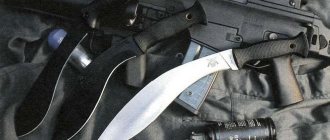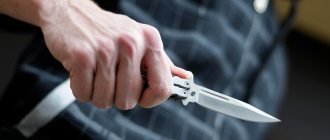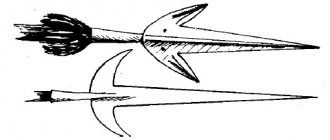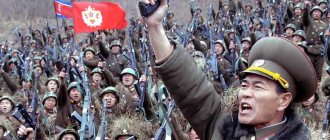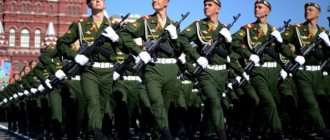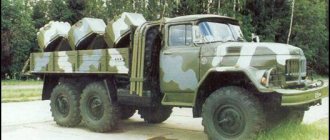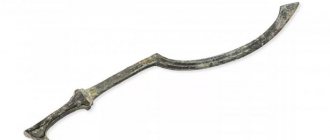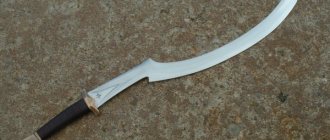One of the first objects in history, for attack or defense, man used a knife. Today, the blade production industry has reached unprecedented proportions. You can find a wide variety of this product in store windows. It is no secret that there are a great many varieties of them, both in purpose and in the nature of production. Each direction has its own separate history. The broadest of the directions is undoubtedly combat knives. Let's try to talk about them today.
Modern combat knives.
The history of military knives
It is no secret that knives in the form of stones have been used for a very long time; their purpose was more specifically for household and household needs. The stages of using copper, bronze and iron for their manufacture have passed. And the time has come to use various alloys.
In the USSR, after the end of the Great Patriotic War, they tried to confiscate the army knife from the common population. They were used for their intended purpose, specifically in the army. There is nothing wrong with this; the stores sold tourist and kitchen knives and folding knives of various types.
That is, there were no problems using the blades. Nowadays, you can buy a knife for almost any purpose, with documents and everything you need to avoid going to jail. Accordingly, such products should be used directly for their intended purpose.
But many knife lovers, the so-called “knife lovers,” purchase blades purely for collecting. This is also a so-called hobby, and it is not prohibited by law. In various martial arts schools, they devote a lot of time to preparing students to repel an attack with a knife or bare hands.
Many people say that the USSR killed the culture of using a knife, but we disagree with this statement, since each blade must fulfill its purpose.
Special Purpose Knives in the Age of Firearms
Today there is a tendency for an army knife to gradually transform into a tactical blade. The explanation for this is simple - in the armed forces of various countries, firearms with a silencer have more often been used to silently neutralize the enemy.
A special purpose knife in the era of firearms.
The developers are trying to bring it to universality in all available ways. And he will really help the fighter in any difficult situation. Even when opening a canned food item, you can use your “sharp assistant.”
Nothing can be done, progress does not stand still. If this method is more effective, then it is worth it. But there is no idea even close to depriving the soldier of chemical weapons.
Gradual transformation into a tactical blade does not deprive it of great capabilities. It has become better and more functional.
Walkie Talkie
Modern radio stations allow you to stay in touch even on the battlefield.
What can radically change the combat situation. With the help of a walkie-talkie, fighters can call for air support, request evacuation, transmit intelligence data and much more. But there is usually only one long-distance (satellite) radio per squad. (Photo: Vitaly Kuzmin)
Within the group, communication takes place over other frequencies and over short distances. For such purposes, there are devices that are more compact and resistant to external influences. Each fighter uses special headphones and a microphone (or laryngophone) for negotiations, which are attached to elements of equipment (helmet or clothing). The radios themselves - despite their complete (if possible) protection from water, dust and shocks - they try to put them in deep pouches so as not to expose them to unnecessary risk. For there is nothing worse than a detachment left without communication: in this case, from a combat unit, it turns into a group of individual soldiers. This is a sure path to defeat, and therefore not the path of special forces.
Distinctive features of combat knives
The direct purpose of a combat knife is clear and understandable to everyone. Inflict damage to enemy personnel. This is why they are equated to edged weapons. It is accompanied by special documents and regulations, and there must be special storage.
In shape and appearance, special-purpose blades can differ from each other, but there are certain parameters that are typical for all combat knives. Specialists involved in the study and manufacture of such products identify several main key parameters:
- Sharpening is very important; a combination of reverse and differentiated is considered optimal;
- the sharpening angle is reduced, allowing to increase its cutting ability, the blade must be at least 2.5-3 cm;
- the oval shape for the handle is the most optimal, it is more ergonomic for the hand;
- to prevent the hand from slipping onto the blade, a limiter on the handle is simply necessary;
- blade with double-sided or one-and-a-half sharpening;
- the handle is made of various plastics, which helps to slip less in the hand;
- the blade must be made of good carbon steel, and its hardness is at least 58-62 HRC;
- the size of the blade is no more than 30 cm, otherwise it will be simply inconvenient, and no less than 18 cm, such dimensions are enough to damage the internal organs of the enemy.
Combat knife and case for it.
The weight of a combat knife should be between 200-300 grams. The penetrating ability of a blade depends not only on its hardness, but also on the shape of the blade. And the center of gravity needs to be focused on the tip, which is necessary for piercing blows.
Which steel is better to choose
When choosing a kitchen knife or hunting blade, the quality of the material and the reputation of the manufacturer are taken into account.
For kitchen knives
To be used in the kitchen, a knife must be durable. An important parameter is the quality of the cut. The blades should be easy to sharpen, but not require frequent editing.
The best kitchen knives meet the following parameters:
- rust resistant;
- do not crumble;
- have a homogeneous fabric without streaks or bubbles.
Another parameter is the absence of irregularities on the cutting edge.
Kitchen knife made of steel 65Х13 with chromium content.
In Russia, the following brands are most often used for kitchen knives:
- 65Х13;
- 40X12;
- 95X18;
- 50Х14МФ.
Among foreign brands, 440C steel has a high rating. For kitchen knives, Japanese steels AUS10 and ATS34, as well as American grade 154 CM (USA), are recommended. Steel 420 is often used by foreign manufacturers, but preference should be given to manufacturers from the USA, Switzerland, Austria, and Germany.
Spanish knives made of 420 steel are soft. In European versions, a massive blade is often found, which makes it difficult to accurately cut food.
For hunting knives
Tourist and hunting blades must be made of durable material.
Examples of knives made of steel 95X18.
Brands often used:
- 420 (inexpensive models);
- 440A, B, C;
- AUS 4-10;
- Elmax;
- 95X18;
- H1 (American chromium-nickel steel).
The blade must have different cutting characteristics, remain sharp for a long time, be durable, and not crumble. Alloys with a hardness below 55 and above 60 units are not suitable for a hunting knife. according to the Rockwell scale. In the first case, the canvas will quickly lose its sharpness, in the second, it will be difficult to straighten. Material with a higher hardness rating may break.
Combat knives and bayonets of the First and Second World Wars
Undoubtedly, the bayonet for the Mosin rifle, which began to be produced in 1891, can be called famous and widely known. Tetrahedral and sharp as a needle, up to half a meter long. In a bayonet attack he was unsurpassed.
By the way, in the armies of European countries there was no such concept at all, and the bayonet was the last chance. Suvorov’s famous expression: “The bullet is stupid, the bayonet is great,” came precisely from those deadly bayonet attacks.
This famous product existed for almost half a century, it went through both the First World War and the Civil War, and killed many Nazis in the Great Patriotic War. This is reflected in many posters of that time.
The First World War had one distinctive characteristic: after maneuver battles, it turned into positional battles. And many thousands of kilometers were covered with trenches, and often clashes between opposing sides ended in hand-to-hand combat. In this case, the long bayonet was inconvenient.
The soldiers had to “extricate themselves” themselves. The French made cutlasses, similar to those for cutting meat, right on the battlefield; the Russians used Plastun knives quite well. The Germans often took a sharpened sapper blade instead of blades. The Austrians armed themselves with spiked clubs. The situation was – who can do what.
Combat knife HP-40.
But still, some countries gradually began to manufacture special trench (trench) blades. And no longer “on the knee,” but on an industrial scale. They all had approximately the same characteristics, a 15 cm blade, double or one and a half sharpening, and always a comfortable handle. Let's look at some of them:
- The Germans distinguished themselves with a gravity folding blade for their airborne forces, which was used by both tankers and pilots. They quickly gave it a name - a knife for the Luftwaffe;
- our representative, the “forefather” of all NRs – “NA-40”. It was made for machine gunners, but found its calling among intelligence officers. The handle is made of wooden beams and the scabbard is also made of wood. Total length 26 cm, narrow blade 2.2 cm made of carbon steel;
- Since childhood, Finns had the skills to handle their national blade “Puukko” and wielded it superbly. They treated him on a first-name basis, removed the guards and threw him well at the enemy. He behaved excellently in the trench “massacre”;
- The Russians also distinguished themselves with their legendary blade, repeating the traditional “finka” in its shape. Single-sided sharpening, beveled butt, wooden handle. They armed them with scouts and attack aircraft. For those who haven’t guessed yet, this is the “NR-40”;
- an improved variation of the HP-40, released in 1943 and receiving a plastic handle. Combat knife “NR-43” “Cherry” The straight guard and the metal tip of the handle were its distinctive features;
- An English “brainchild”, the knife had a narrow blade, 18.5 cm long, with a dagger sharpening. Apart from its main function, it cannot do anything else; its name is “Fairbain-Sykes”;
- An American design with brass knuckles on the handle, it was very useful in close combat. The comfortable handle helped them make piercing blows quite well, but cutting and chopping movements were inconvenient for them. It was called “Knuckle Knife”;
- Another interesting US development, the Mk-II knife, was intended for marines, the design was very reminiscent of the famous Bowie. It is still used today, in service with the Americans.
Such a rather meager arsenal was possessed by opponents and allies. Of course, this is an unknown list of blades from the First and Second World Wars. And the brightest and most memorable representatives of bygone times.
Two types of Caucasian daggers
For residents of the Caucasus, the dagger is a symbol of pride. At the birth of a child, he was given a symbol of his people, and upon reaching 14 years of age, the father presented a dagger that looked more like a work of art. In addition to beauty, the double-edged blade was distinguished by its combat characteristics.
Caucasian daggers were created for injuring the enemy. Among the knives characteristic of the Caucasus, it is worth noting the kama, a weapon with a straight blade, and the bebut, a curved blade.
Kama had a shape that is now called drop point. This is a double-edged knife that tapers at the end. It was distinguished by a short handle and the presence of linings made from horn or bone.
Caucasian dagger Kama
Bebut was less common; the knife has a characteristic spear point sharpening. Both Caucasian traditional models of edged weapons have a respectable length of more than 400 mm, the blade has fullers to increase strength. The weapon with a forked blade was equipped with a scabbard made of wood covered with leather. The scabbard had a ring through which the bladed weapon was attached to the belt.
Caucasian dagger Bebut
Bayonet knives of the post-war period
Without a shadow of doubt or embarrassment, we must boldly say that the bayonet for the AK-47 assault rifle is the most famous in the whole world. Throughout its existence, it has undergone several design changes. It is still in service today, although many recognize its irrelevance. It first appeared in the “combat arena” in 1953, and was quite simple.
Its new variation of the 1978 model has already received a new shape, a saw on the butt and a plastic handle, and there was also a hole on the blade. Using the sheath together, they could cut the wire. In 1989, another modification was made and until today it has not changed.
Carrying edged weapons
Only persons who have the appropriate permission - a license - can carry edged weapons. They receive this document from the police, having previously confirmed the absence of mental illness and unhealthy addictions such as drugs or alcohol. To do this, you must provide the police with a certificate from a psychiatrist and narcologist.
Citizens can legally purchase bladed hunting weapons, or types of national products (checkers, daggers, etc.). You can also own award-winning weapons, but they are prohibited from being given, sold, or inherited. In this case, carrying such a weapon must meet the following requirements:
- the right to carry must be confirmed by a license, which must be carried with you and a passport confirming the identity of the owner;
- wearing should be safe for others and the owner himself (in a sheath, case, etc.).
It is strictly unacceptable to carry bladed weapons with you to public events, political meetings and rallies, or cultural festivals, concerts, etc.
Video on the topic:
Modern combat and tactical knives of Russia
It just so happened that the gradual evolution of the combat knife moved into the “mixed stage”. This group teamed up with survival models.
And at the moment, a modern combat blade has practically no differences from a tactical one. There is nothing wrong with this, but, on the contrary, they combined two in one. Let's look at the most popular of them.
Shaitan
“Shaitan” - a combat dagger was developed for the “Ministry of Internal Affairs of the Republic of Tatarstan”. The narrow blade causes deep penetrating wounds and has a double-sided sharpening. Closer to the handle, there is a serrator. Developed in 2001, well balanced for throwing.
Shaitan combat knife.
NRS-2
"NRS-2", a blade modified many times, is intended for the Airborne Forces and Marine Corps. In 1986, it was changed for the final time, it is not known how many times.
The NRS-1 model had the ability to fire, the NRS-2 did not lose it, but the cartridge was replaced with a silent SP-4. The blade became spear-shaped, and the saw on the butt was almost halved. Currently, it is used by special forces of the Ministry of Internal Affairs, Airborne Forces and Marine Corps.
Combat knife NRS-2.
chastener
“The Punisher” is represented by a line of two models “Vzmakh-1” and “Maestro”, the handle is made of inlaid leather or rubber. The knife is intended for the FSB. The difference is almost only in the serrator; in the first model it is closer to the handle on the lower edge, and in the second in the same place only on the upper edge.
Combat knife Punisher.
The double-sided guard does not allow the hand to slip, and the cutting surface has a crescent-shaped cavity. The sheath can be attached to any part of the body and clothing.
In fact, there is another variety of this blade, “Vzmakh-3,” made specifically for sappers, and has in its arsenal: wire cutters, a ruler, a saw, a sling cutter, an awl, a nail puller, and 3 screwdrivers. Where it all fit is a mystery. But the fact remains a fact.
Anti-terror
“Anti-terror”, again intended for the FSB of the Russian Federation, the blade has a petal shape, the cutting and penetrating ability is quite good. The cutting edge has a crescent-shaped cavity, the butt has a serrated sharpening, the guard and handle are quite ergonomic, it is very convenient to work with such a knife.
Combat knife Anti-terror.
Katran-1
"Katran-1", a combat knife for GRU special forces, is intended for combat swimmers; the blade near the handle has a hook and a serrated sharpening nearby, for quickly cutting ropes and nets.
Combat knife Katran-1.
The handle is made of rubber. The knife has different varieties, depending on the tasks. The blade has a wave-shaped sharpening. An underwater knife is a completely separate topic; the most terrible underwater enemy is nets.
Gyurza
“Gyurza”, the blade was created for the FSB, has a one-and-a-half sharpening and is equipped with a serrated blade. There is a metal tip on the handle, which is convenient for delivering shocking blows to the enemy.
Combat knife "Gyurza".
Katran-1S
“Katran-1S”, a land version of the blade, has a dagger sharpening and two serrators on the sides closer to the butt. The whole thing is covered with anti-reflective coating.
Combat knife Katran-1S.
Lynx
“Lynx” is manufactured specifically for SOBR units in the famous arms city of Zlatoust. It is performed in three variations: combat, award and civilian.
Spindle-shaped handle, small guard, metal pommel. The shape is quite attractive. Award examples are made with gilding; civilian versions have a slightly different guard and butt.
Combat knife Lynx.
Cobra
“Cobra”, the main customer was the Russian SOBR, the blade is dagger-shaped, quite narrow with a double-sided sharpening. Its shape is intended for delivering cutting and piercing blows.
Combat knife Cobra.
Explosive technician
“Vzryvotekhnik”, judging by the name, it becomes clear that it is intended for sappers, its length is 18 cm, and can be used as a military weapon. And also when working with explosive substances, the sharpening is double-sided, there is a serrator. Wooden handle with metal pommel.
Combat knife Explosive technician.
DV-1 and DV-2
"DV-1" and "DV-2" are intended for army units. The knives are almost identical, except for the length of the blade. They can withstand heavy loads and can be used not only as a weapon, but also as a digging object.
Oval walnut handle. The blade is spear-shaped, has a clear guard, and is covered entirely with an anti-reflective coating.
Combat knife DV-1.
Basurmanin
“Basurmanin” is actually a survival knife, dagger-shaped, sharpened on one side. The handle is steel with notches; inside there is a cavity for various small items such as matches. But the sheath is a separate issue, with a saw, wire cutters, screwdriver and wrench.
Combat knife Basurmanin.
Werewolf
“Werewolf”, a very reliable weapon, is used both in everyday life and for combat. The folding handles of the knife hide: a screwdriver, a nail puller, two saws, an opener, etc. It's more of a tool than a weapon.
Werewolf combat knife.
Elf
“Elf”, the customer was the GRU MO, a rather narrow blade, one-sided sharpening with a false blade, immediately after it there is a serrator on the butt. Combat effectiveness is very high.
Elf combat knife.
I would like to immediately note that the order of knives is simply the order of publication and in no way any “place in the ranking”. The most famous models of “combat-tactical” knives were simply listed.
Properties of powder steel
The powder steel manufacturing process comes down to the basic steps: production and mixing of powders, compaction and sintering. Manufacturers may have different process specifications.
Knives made of this steel are more expensive. The quality of the finished product depends on the size and distribution of the carbides formed. Using the technique allows manufacturers to obtain a high-tech alloy, increase the number of alloyed elements, and improve the characteristics of the material.
Most military and hunting knives are made using powder technology, because... in these cases, increased strength is required in combination with anti-corrosion properties.
Powdered steel blades are sharper than solid metal prototypes. Withstands temperature changes, is resistant to deformation, and can be sanded. The cutting edge retains its sharpness for a long time.
At home, powder steel requires careful sharpening.
Foreign combat knives
It is clear that not only Russia produces combat-type knives, but in fact the whole world. And many world manufacturers are not inferior to our blades, and, perhaps, even superior in some places.
It is simply impossible to list all the knives; no one has ever counted their number, but, apparently, it will be a huge number. In this regard, it is best to touch on the most popular and popular copies:
- created a magnificent blade called “Eickhorn Kampfmesser 2000” and already in 2001 it was immediately adopted by the Bundeswehr. There is a guard and a plastic handle. The shape of the blade is quite curious, very similar to Japanese knives, they have a one-sided sharpening and a serrated half of the cutting edge;
- Italians also know how to make knives that can withstand a load of 150 kg, the shape of the blade allows them to chop, and deliver piercing and cutting blows. The name of this wonderful knife is “Extrema Ratio Fulcrum S”. Closer to the blade there is a serrator on the blade, a plastic handle, and a guard;
- The Americans distinguished themselves with one very interesting and futuristic model, the CQD Mark V ATAC, which did a great job. The design of the blade is quite unusual, but multifunctional, has a dagger sharpening, its length is 17.1 cm. It is capable of delivering cutting and piercing blows. The most interesting point is its guard, which gives the blade a very “dangerous” look and unusualness. The carbon fiber handle and pommel can be used as a hammer;
- a modern replica of the famous combat knife from the Second World War “Mk II”, it is called “Next Generation Fighter”. The look, as before, is reminiscent of the famous “Bowie”, one-sided sharpening, comfortable guard, plastic handle. The blade has a decent weight category;
- The main American knife in service with pilots for almost 50 years was the Camillus, its history told the developers of its “big brother” how to achieve perfection, and the ASEK Survival Knife System (Ontario) was manufactured. It is made of high-strength steel, minimally susceptible to corrosion, and has a saw on the butt. Holes are drilled in the guard to make a spear from a knife;
- a blade made for the US Navy, based on the same Mk II. The guard and handle are straight, the pommel is large, which allows them to work like a hammer. One-and-a-half sharpened blade with saw;
- combat knife, it feels like it’s back from the past, “Ontario SP15 LSA”. The guard is straight, and the handle is made in the form of an oval with large cutouts. The blade is a dagger-shaped one-and-a-half, and with a large serrated. It is comfortable in the hand and for stabbing.
Foreign combat knife.
This list mainly contains American knife models. If you honestly look at the situation in the United States, taking at least a firearm, every family there is armed with one, and there’s nothing to say about cold weapons.
Blades are in great demand there, like “hot cakes”. The knife production industry is highly developed.
Typical sharpening shapes
Below will be presented typical forms of blade sharpening that are used on combat knives.
Wedge sharpening. This is a classic sharpening form that is well suited for blades that experience significant stress. Such a knife can be used not only as a weapon, but also as a tool . The blade from the blade thickens upward evenly. A thinner wedge cuts better, leaves less waste, but is less durable.
Dove sharpening. It is made in the form of a narrow, very thin blade that cuts perfectly and is highly sharp. This kind of sharpening is also called razor sharpening. However, there is also a negative side to this: such a blade is less durable than with a wedge sharpening. Typically, such knives have a massive spine, which ensures the strength of the blade. Knives with wedge-shaped sharpening are intended exclusively for cutting; using them as a tool is extremely problematic.
Sharpening in the form of a chisel. A similar sharpening is used in Japanese kitchen knives, and it is a single-sided wedge-shaped sharpening. There is controversy as to which side it is better to do it on, the right or left. When working, it is necessary that the sharpened side is on top. This is exactly how a carpenter works with a chisel. It turns out that such knives need to be made separately for left-handers and for those who are better with their right hand.
Convex sharpening. This type of sharpening is rarely used for combat knives; it is most often used when sharpening axes. Knives that use a convex sharpening are most often used as cleavers.
Japanese fighting knives
In the 10th century AD, the first mentions of tanto appeared. Then they had a simple, unattractive appearance. Over time, they became more and more interesting and their production gained momentum.
Tanto was considered a samurai combat knife and has a one-sided sharpening. It differs from other swords in size, and has several varieties:
- the blade was sharpened on one side, and in rare cases on both. The length could reach 30 cm, the metal for forging was “spongy”, the handle was removable. The guard has a round shape, the main goal is to finish off the enemy;
- a type of tanto knife “Aykutti”, the main difference is that it does not have a guard, and is slightly smaller in size. In hand-to-hand combat, its small size is very helpful in finishing off the enemy;
- another follower of the Tanto-ken knife, one of the oldest representatives of tanto, double-sided sharpening. Today it is no longer in use and is a work of art;
- quite an interesting and multifunctional copy of the “Yari-tanto”. The blade was spear-shaped for piercing through armor, and the handle on the back had a cavity for putting it on a stick. Thus, a full-fledged spear was obtained;
- The military use of the blade, called the Hashiwari Knife, was very effective for intercepting an enemy's knife or saber. Thanks to the hook of the next one after the guard.
Japanese combat knife.
In modern Japan, in order to start making tanto knives, you first need to undergo a long training and then obtain a license to make it. And the blades made by the masters are equated with the cultural values of the nation.
All knives made in a factory during the Second World War have no value and must be destroyed.
Previous
Combat knivesKnife “Werewolf” - multifunctional balisong
Next
Combat knivesUS Marine Corps Ka-Bar Knife
What criteria must steel meet?
Different types of steel have different technological and mechanical properties due to the presence of alloying elements in the alloy.
Material for making knives is assessed according to the following criteria:
- Resistant to a wide temperature range (-30…+100°C).
- Sensitivity to corrosion.
- Strength, elasticity. When using the product, minimal deformation of the metal and resistance to longitudinal deflection are important.
- Hardness. The indicator is denoted by the abbreviation HRC (in Europe - RC), assessed on the Rockwell scale. For knives, an indicator above 55 units is considered optimal. As hardness increases, chip resistance decreases.
- Holding an edge. The harder the material, the less often the blade becomes dull.
Another criterion is the ease of sharpening the blade. The softer the material, the easier it is to sharpen (the steel dulls faster). Therefore, a balance between hardness and strength is important.
There is no clear answer to the question of which steel is the best. Priority characteristics should ensure the functionality of the knife to perform the assigned tasks.
